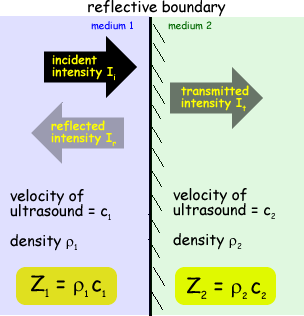|
The strength of the reflected sound wave depends on the difference in "acoustic impedance" between adjacent structures.
Acoustic impedance (Z) is defined as the product of density ( ) and the velocity of the sound in that material (c). ) and the velocity of the sound in that material (c).

The fraction of the incident intensity that is reflected is given by the equation:

where
- Ir = reflected intensity
- Io = incident intensity
- Z2 =
 2c2 = acoustic impedance of medium 2 2c2 = acoustic impedance of medium 2
- Z1 =
 1 c1 = acoustic impedance of medium 1 1 c1 = acoustic impedance of medium 1
The greater the difference in acoustic impedance between two adjacent tissues the more ultrasound energy the boundary will reflect .
Sound waves are propagated at a speed of approximately 340 m/s in air and 1540 m/s in soft tissues. This big difference means that if a coupling gel is needed between the body of the patient and the ultrasound transducer. The gel forces out the air between the body and the transducer window and replaces it with a medium that allows ultrasound to travel through it at a speed closer to that of the body.
The difference in acoustic impedances of two soft tissues is small and only about one per cent of the energy of theultrasonic beam is reflected. However, this is sufficient to produce a detectable echo. More intense echoes are produced at 'bone-soft tissue' boundaries since the impedance difference is large. Similarly, an 'air-soft tissue' boundary reflects almost all of the incident pulse because of the large impedance differences. Therefore the presence of air within the body (ie in the lungs) prevents structures behind it from being examined.
material |
velocity
/ms-1 |
density
/ kg m-3 |
acoustic impedance Z
/
kg m-2 s-1 × 106 |
air |
330 |
1.3 |
4.29 × 10-4 |
oil
|
1500 |
950 |
1.42 |
Perspex |
2680 |
1200 |
3.22 |
water |
1500 |
1000 |
1.50 |
| bone
|
4080 |
1908 |
7.78 |
brain |
1540 |
1025 |
1.58 |
muscle |
1580 |
1075 |
1.70 |
| liver
|
1585 |
1042 |
1.65 |
fat |
1450 |
952 |
1.38 |
Note:
 The acoustic impedance of soft tissue is about 10% greater than that of water and is much greater than that of air. The acoustic impedance of soft tissue is about 10% greater than that of water and is much greater than that of air.
 The acoustic impedance of bone is about 5 × that of soft tissue. The acoustic impedance of bone is about 5 × that of soft tissue.
 Z should technically be referred to as the specific acoustic impedance of the substance as it is a property of the substance and does not depend on the area of cross-section or length of the substance... but examiners often just say 'acoustic impedance' Z should technically be referred to as the specific acoustic impedance of the substance as it is a property of the substance and does not depend on the area of cross-section or length of the substance... but examiners often just say 'acoustic impedance'
|